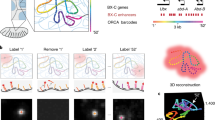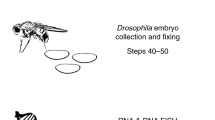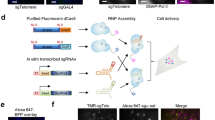Abstract
Dynamic reprogramming of the genome takes place during the gamete-to-embryo transition. This transition defines a period of continuous and global change but has been difficult to study because of extremely limited material and varying degrees of chromatin compaction. Improved methods of detecting chromatin and gene expression changes in the germ line and in the preimplantation embryo would greatly enhance the understanding of this crucial developmental transition. Here we describe a protocol developed and used by us that improves the sensitivity of existing fluorescence in situ hybridization (FISH) methods; the protocol described here has enabled us to visualize single-copy DNA targets and corresponding nascent RNA transcripts in preimplantation embryos and during spermatogenesis. Major improvements over alternative methods involve fixation and permeabilization steps. Chromatin epitopes can be visualized simultaneously by combining FISH with immunofluorescence; multicopy and repetitive element expression can also be reliably measured. This procedure (sample preparation and staining) requires 1–1.5 d to complete and will facilitate detailed examination of spatial relationships between chromatin epitopes, DNA and RNA during the dynamic transition from gamete to embryo.
This is a preview of subscription content, access via your institution
Access options
Subscribe to this journal
Receive 12 print issues and online access
$259.00 per year
only $21.58 per issue
Buy this article
- Purchase on Springer Link
- Instant access to full article PDF
Prices may be subject to local taxes which are calculated during checkout





Similar content being viewed by others
References
Youngson, N.A. & Whitelaw, E. Transgenerational epigenetic effects. Annu. Rev. Genomics Hum. Genet. 9, 233–257 (2008).
Carrell, D.T. & Hammoud, S.S. The human sperm epigenome and its potential role in embryonic development. Mol. Hum. Reprod. 16, 37–47 (2010).
Cooper, D.W. Directed genetic change model for X chromosome inactivation in eutherian mammals. Nature 230, 292–294 (1971).
Lyon, M.F. Imprinting and X chromosome inactivation In Results and Problems in Cell Differentiation (ed. Ohlsson, R.) 73–90 (Springer-Verlag, 1999).
McCarrey, J.R. X-chromosome inactivation during spermatogenesis: the original dosage compensation mechanism in mammals? In Gene Families: Studies of DNA, RNA, Enzymes, and Proteins (eds. Xue, G. et al.) 59–72 (World Scientific Publishing Co., 2001).
Huynh, K.D. & Lee, J.T. Inheritance of a pre-inactivated paternal X chromosome in early mouse embryos. Nature 426, 857–862 (2003).
Huynh, K.D. & Lee, J.T. X-chromosome inactivation: a hypothesis linking ontogeny and phylogeny. Nat. Rev. Genet. 6, 410–418 (2005).
Hammoud, S.S. et al. Distinctive chromatin in human sperm packages genes for embryo development. Nature 460, 473–478 (2009).
Arpanahi, A. et al. Endonuclease-sensitive regions of human spermatozoal chromatin are highly enriched in promoter and CTCF binding sequences. Genome Res. 19, 1338–1349 (2009).
Brykczynska, U. et al. Repressive and active histone methylation mark distinct promoters in human and mouse spermatozoa. Nat. Struct. Mol. Biol. 17, 679–687 (2010).
Darzacq, X. et al. Imaging transcription in living cells. Annu. Rev. Biophys. 38, 173–196 (2009).
Clemson, C.M. et al. An architectural role for a nuclear noncoding RNA: NEAT1 RNA is essential for the structure of paraspeckles. Mol. Cell 33, 717–726 (2009).
Cremer, T. & Cremer, M. Chromosome territories. Cold Spring Harb. Perspect Biol. 2, a003889 (2010).
Zhao, R., Bodnar, M.S. & Spector, D.L. Nuclear neighborhoods and gene expression. Curr. Opin. Genet. Dev. 19, 172–179 (2009).
Namekawa, S.H. et al. Postmeiotic sex chromatin in the male germline of mice. Curr. Biol. 16, 660–667 (2006).
Namekawa, S.H., Payer, B., Huynh, K.D., Jaenisch, R. & Lee, J.T. Two-step imprinted X inactivation: repeat versus genic silencing in the mouse. Mol. Cell Biol. 30, 3187–3205 (2010).
Turner, J.M., Mahadevaiah, S.K., Ellis, P.J., Mitchell, M.J. & Burgoyne, P.S. Pachytene asynapsis drives meiotic sex chromosome inactivation and leads to substantial postmeiotic repression in spermatids. Dev. Cell 10, 521–529 (2006).
Okamoto, I. et al. Evidence for de novo imprinted X-chromosome inactivation independent of meiotic inactivation in mice. Nature 438, 369–373 (2005).
Okamoto, I., Otte, A.P., Allis, C.D., Reinberg, D. & Heard, E. Epigenetic dynamics of imprinted X inactivation during early mouse development. Science 303, 644–649 (2004).
Panning, B. X inactivation in mouse ES cells: histone modifications and FISH. Methods Enzymol. 376, 419–428 (2004).
Erwin, J.A. & Lee, J.T. Characterization of X-chromosome inactivation status in human pluripotent stem cells. Curr. Protoc. Stem Cell Biol. Chapter 1 Unit 1B 6 (2010).
Peters, A.H., Plug, A.W., van Vugt, M.J. & de Boer, P. A drying-down technique for the spreading of mammalian meiocytes from the male and female germline. Chromosome Res. 5, 66–68 (1997).
Barlow, A.L., Benson, F.E., West, S.C. & Hulten, M.A. Distribution of the Rad51 recombinase in human and mouse spermatocytes. EMBO J. 16, 5207–5215 (1997).
Hall, L.L. et al. An ectopic human XIST gene can induce chromosome inactivation in postdifferentiation human HT-1080 cells. Proc. Natl. Acad. Sci. USA 99, 8677–8682 (2002).
Namekawa, S.H., VandeBerg, J.L., McCarrey, J.R. & Lee, J.T. Sex chromosome silencing in the marsupial male germ line. Proc. Natl. Acad. Sci. USA 104, 9730–9735 (2007).
Greaves, I.K., Rangasamy, D., Devoy, M., Marshall Graves, J.A. & Tremethick, D.J. The X and Y chromosomes assemble into H2A.Z, containing facultative heterochromatin, following meiosis. Mol. Cell Biol. 26, 5394–5405 (2006).
Khalil, A.M., Boyar, F.Z. & Driscoll, D.J. Dynamic histone modifications mark sex chromosome inactivation and reactivation during mammalian spermatogenesis. Proc. Natl. Acad. Sci. USA 101, 16583–16587 (2004).
Okamoto, I. et al. Evaluating the role of inducible nitric oxide synthase using a novel and selective inducible nitric oxide synthase inhibitor in septic lung injury produced by cecal ligation and puncture. Am. J. Respir. Crit. Care Med. 162 (2 Pt 1): 716–722 (2000).
Ohno, M., Aoki, N. & Sasaki, H. Allele-specific detection of nascent transcripts by fluorescence in situ hybridization reveals temporal and culture-induced changes in Igf2 imprinting during pre-implantation mouse development. Genes Cells 6, 249–259 (2001).
Silva, J. et al. Establishment of histone h3 methylation on the inactive X chromosome requires transient recruitment of Eed-Enx1 polycomb group complexes. Dev. Cell 4, 481–495 (2003).
Patrat, C. et al. Dynamic changes in paternal X-chromosome activity during imprinted X-chromosome inactivation in mice. Proc. Natl. Acad. Sci. USA 106, 5198–5203 (2009).
Nagy, A., Gertsenstein, M., Vintersen, K. & Behringer, R. Manipulating the Mouse Embryo (Cold Spring Harbor Laboratory Press, 2003).
Beatty, B., Mai, S. & Squire, J. FISH. A Practical Approach (Oxford University Press, 2002).
Zhang, L.F., Huynh, K.D. & Lee, J.T. Perinucleolar targeting of the inactive X during S phase: evidence for a role in the maintenance of silencing. Cell 129, 693–706 (2007).
Acknowledgements
We thank K. Hyunh, B. Payer and L.-F. Zhang for their assistance to optimize experimental conditions during the initial phases of these works. The studies have been supported by National Institutes of Health grant RO1-GM58839 to J.T.L. S.H.N. was supported by the research fellowships of the Japan Society for the Promotion of Science (JSPS) and the Charles King Trust. J.T.L. is an Investigator of the Howard Hughes Medical Institute.
Author information
Authors and Affiliations
Contributions
S.H.N. and J.T.L. wrote the manuscript. S.H.N. designed the protocols, with guidance from lab protocols, and J.T.L. and S.H.N. conducted the experiments. J.T.L. supervised the projects.
Corresponding authors
Ethics declarations
Competing interests
The authors declare no competing financial interests.
Rights and permissions
About this article
Cite this article
Namekawa, S., Lee, J. Detection of nascent RNA, single-copy DNA and protein localization by immunoFISH in mouse germ cells and preimplantation embryos. Nat Protoc 6, 270–284 (2011). https://doi.org/10.1038/nprot.2010.195
Published:
Issue Date:
DOI: https://doi.org/10.1038/nprot.2010.195
This article is cited by
-
Active DNA damage response signaling initiates and maintains meiotic sex chromosome inactivation
Nature Communications (2022)
-
BRUCE preserves genomic stability in the male germline of mice
Cell Death & Differentiation (2020)
-
No imprinted XIST expression in pigs: biallelic XIST expression in early embryos and random X inactivation in placentas
Cellular and Molecular Life Sciences (2019)
-
Alternative dominance of the parental genomes in hybrid cells generated through the fusion of mouse embryonic stem cells with fibroblasts
Scientific Reports (2017)
-
lncRNA DANCR suppresses odontoblast-like differentiation of human dental pulp cells by inhibiting wnt/β-catenin pathway
Cell and Tissue Research (2016)
Comments
By submitting a comment you agree to abide by our Terms and Community Guidelines. If you find something abusive or that does not comply with our terms or guidelines please flag it as inappropriate.



